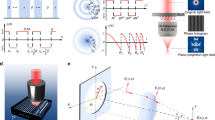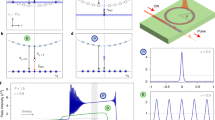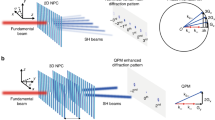Abstract
Diffraction, a fundamental process in wave physics, leads to spreading of the optical beams as they propagate. However, new photonic crystal (PhC) meta-materials can be nano-engineered to generate extreme anisotropy, resulting in apparent propagation of light without diffraction. This surprising phenomenon, called supercollimation, effectively freezes the spatial width of a light beam inside a PhC, observed over a few isotropic diffraction-lengths1,2,3,4,5,6. However, using such experiments to predict the behaviour for longer propagation lengths is difficult, as a tiny error in a measured width can extrapolate to order unity uncertainty in the width at distances over hundreds of diffraction-lengths. Here, supercollimation is demonstrated in a macroscopic PhC system over centimetre-scale distances, retaining spatial width confinement without the need for waveguides or nonlinearities. Through quantitative studies of the beam evolution in a two-dimensional PhC, we find that supercollimation possesses unexpected but inherent robustness with respect to short-scale disorder such as fabrication roughness, enabling supercollimation over 600 isotropic diffraction-lengths. The effects of disorder are identified through experiments and understood through rigorous simulations. In addition, a supercollimation steering capability is proposed.
This is a preview of subscription content, access via your institution
Access options
Subscribe to this journal
Receive 12 print issues and online access
$259.00 per year
only $21.58 per issue
Buy this article
- Purchase on Springer Link
- Instant access to full article PDF
Prices may be subject to local taxes which are calculated during checkout



Similar content being viewed by others
References
Kosaka, H. et al. Self-collimating phenomena in photonic crystals. Appl. Phys. Lett. 74, 1212–1214 (1999).
Kosaka, H., Kawashima, T., Tomita, A., Sato, T. & Kawakami, S. Photonic-crystal spot-size converter. Appl. Phys. Lett. 76, 268–270 (2000).
Wu, L. J., Mazilu, M. & Krauss, T. F. Beam steering in planar-photonic crystals: From superprism to supercollimator. J. Lightwave Technol. 21, 561–566 (2003).
Prather, D. W. et al. Dispersion-based optical routing in photonic crystals. Opt. Lett. 29, 50–52 (2004).
Pustai, D. M., Shi, S. Y., Chen, C. H., Sharkawy, A. & Prather, D. W. Analysis of splitters for self-collimated beams in planar photonic crystals. Opt. Express 12, 1823–1831 (2004).
Shi, S. Y., Sharkawy, A., Chen, C. H., Pustai, D. M. & Prather, D. W. Dispersion-based beam splitter in photonic crystals. Opt. Lett. 29, 617–619 (2004).
Yu, X. F. & Fan, S. H. Bends and splitters for self-collimated beams in photonic crystals. Appl. Phys. Lett. 83, 3251–3253 (2003).
Augustin, M. et al. Self-guiding of infrared and visible light in photonic crystal slabs. Appl. Phys. B 81, 313–319 (2005).
Yamashita, T. & Summers, C. J. Evaluation of self-collimated beams in photonic crystals for optical interconnect. IEEE J. Sel. Areas Commun. 23, 1341–1347 (2005).
Tandon, S. N., Soljacic, M., Petrich, G. S., Joannopoulos, J. D. & Kolodziejski, L. A. The superprism effect using large area 2D-periodic photonic crystal slabs. Photon. Nanostruct. 3, 10–18 (2005).
Johnson, S. G. & Joannopoulos, J. D. Block-iterative frequency-domain methods for Maxwell’s equations in a planewave basis. Opt. Express 8, 173–190 (2001).
Witzens, J., Loncar, M. & Scherer, A. Self-collimation in planar photonic crystals. IEEE J. Sel. Top. Quantum Electron. 8, 1246–1257 (2002).
Bourzeix, S. et al. Near-field optical imaging of light propagation in semiconductor waveguide structures. Appl. Phys. Lett. 73, 1035–1037 (1998).
Acknowledgements
This work was supported in part by the Materials Research Science and Engineering Center Program of the National Science Foundation, in the Interconnect Focus Center Research Program at the Massachusetts Institute of Technology by the Microelectronics Advanced Research Corporation (MARCO), its participating companies, DARPA, Department of Defence (ONR) MURI and by AFOSR. We gratefully acknowledge Sensors Unlimited for the donation of an infrared camera. M.S.D. is supported by the Portuguese Science and Technology Foundation (FCT).
Author information
Authors and Affiliations
Corresponding author
Ethics declarations
Competing interests
The authors declare no competing financial interests.
Rights and permissions
About this article
Cite this article
Rakich, P., Dahlem, M., Tandon, S. et al. Achieving centimetre-scale supercollimation in a large-area two-dimensional photonic crystal. Nature Mater 5, 93–96 (2006). https://doi.org/10.1038/nmat1568
Received:
Accepted:
Published:
Issue Date:
DOI: https://doi.org/10.1038/nmat1568
This article is cited by
-
Photonic flatband resonances for free-electron radiation
Nature (2023)
-
Straightening of light in a one dimensional dilute photonic crystal
Scientific Reports (2019)
-
Strong beaming of microwave surface waves with complementary split-ring-resonator arrays
Scientific Reports (2018)
-
Anomalous transparency in photonic crystals and its application to point-by-point grating inscription in photonic crystal fibers
Scientific Reports (2018)
-
Surface phononic graphene
Nature Materials (2016)



